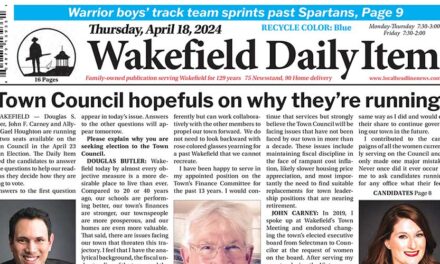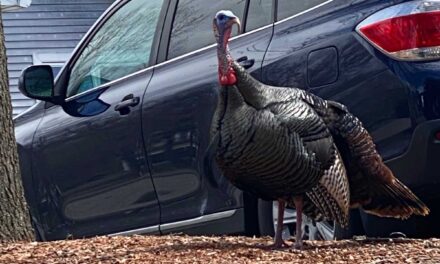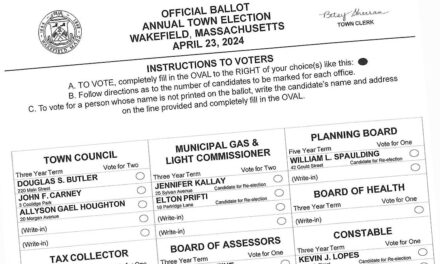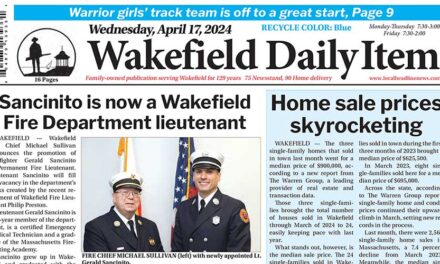Parking ban is on; trash pickup delayed
Published in the December 17, 2020 edition.
WAKEFIELD — As of 8:30 this morning, the town had received about a foot of snow with more on the way.
Additionally, Police Chief Steven A. Skory and Fire Chief Michael Sullivan recommended that residents take the necessary safety precautions to deal with hazardous weather as temperatures continued to drop through the morning and the region remained in the grip of the first major winter storm of the season.
Police said about 35 vehicles had to be towed from streets overnight during a parking ban.
DPW Director Joseph Conway said that unless the area received heavier bands of snow, about 15 inches would fall here by storm’s end.
Crews began pretreating town streets around 9 last night and by 12:15 a.m. today, the DPW and its contracted corps were in full snow removal mode.
The National Weather Service (NWS) predicted hazardous weather conditions with snow accumulations forecast to be six to 10 inches overnight into Thursday, Dec 17. In addition, the area is under a Winter Storm Warning from 7 p.m. Wednesday until 1 p.m. Thursday. Gusty winds accompanied the snow, which was expected to keep falling most of today.
A street parking ban took effect in Wakefield at 10 last night and will remain in effect until 7 a.m. on Friday, Dec. 18. All parked cars must be removed from the roadways to allow plowing crews and public safety vehicles to safely access the roads and perform curb-to-curb cleanup. If your residence does not have a driveway, you are encouraged to connect with your landlord for parking options or coordinate with a neighbor who has extra driveway space.
Trash and recycling will not be picked up on Thursday, December 17. Collection will follow a holiday schedule and be delayed a day; a household with a Thursday pickup, for example, will have its refuse and recycling collected on Friday. Friday collection will move to Saturday.
The Town Hall building will be closed, but staff will still be working and available via phone and email. The Department of Public Works and Fire Department appreciate your assistance helping them clear catch basins and hydrants near your home.
Residents are reminded to stay informed by receiving alerts, warnings, and public safety information before, during, and after emergencies.
The Wakefield Police and Fire Departments wish to share the following winter weather safety tips provided by NWS and Red Cross:
During a winter storm
• Stay indoors and wear warm clothes. Layers of loose-fitting, lightweight, warm clothing will keep you warmer than a bulky sweater. If you feel too warm, remove layers to avoid sweating; if you feel chilled, add layers.
• Bring your companion animals inside before the storm begins. Move other animals to sheltered areas with a supply of non-frozen water. Most animal deaths in winter storms are caused by dehydration.
• Check on relatives, neighbors, and friends, particularly if they are elderly or if they live alone.
If you must go outside, protect yourself from winter storm hazards:
• Wear layered clothing, mittens or gloves, and a hat. Outer garments should be tightly woven and water repellent. Mittens or gloves and a hat will prevent the loss of body heat.
• Cover your mouth to protect your lungs from severely cold air. Avoid taking deep breaths; minimize talking.
• Watch for signs of hypothermia and frostbite.
• Keep dry. Change wet clothing frequently to prevent a loss of body heat. Wet clothing loses much of its insulating value and transmits heat rapidly away from the body.
• Stretch before you go out. If you go out to shovel snow, do a few stretching exercises to warm up your body. This will reduce your chances of muscle injury.
• Avoid overexertion, such as shoveling heavy snow, pushing a vehicle, or walking in deep snow. The strain from the cold and the hard labor may cause a heart attack. Sweating could lead to a chill and hypothermia.
• Walk carefully on snowy, icy sidewalks. Slips and falls occur frequently in winter weather, resulting in painful and sometimes disabling injuries.
• If you must go out during a winter storm, use public transportation if possible. About 70 percent of winter deaths related to ice and snow occur in automobiles.
If you must drive during winter weather conditions:
• Make sure all fluid levels are full and ensure that the lights, heater and windshield wipers are in proper condition.
• Keep your gas tank near full to avoid ice in the tank and fuel lines.
• Avoid traveling alone. Let someone know your timetable and primary and alternate routes.
• Be on the lookout for sleet, freezing rain, freezing drizzle, and dense fog, which can make driving very hazardous.
• Drive slowly and with vigilance.
• Don’t leave the house without the following a fully charged mobile phone, car charger and an emergency supplies kit in your car.
If your car gets stuck during a storm:
• Stay in the vehicle. If you leave your vehicle, you will become disoriented quickly in wind-driven snow and cold.
• Run the motor about 10 minutes each hour for heat. While running the motor, open the window a little for fresh air to avoid carbon monoxide poisoning. Clear snow from the exhaust pipe to avoid gas poisoning.
• Be visible to rescuers. Turn on the dome light at night when running the engine. Tie a bright colored cloth, preferably red, to your antenna or door. After snow stops falling, raise the hood to indicate you need help.
After a winter storm
• Stay informed and pay attention to the information provided by local authorities.
• Avoid driving and other travel until conditions have improved.
• Black ice is patchy ice on roadways that cannot easily be seen. Even if roadways have been cleared of snow following a storm, any water left on the roadways may freeze, resulting in a clear sheet of ice, also known as black ice. It is most dangerous in the early morning due to below freezing nighttime temperatures.
• Know the signs of frostbite and hypothermia.
• Residents are also asked to assist firefighters by clearing snow away from fire hydrants during and after the storm. Snow should be cleared 3 feet all around the hydrant so firefighters have enough room to connect a hose. Clearly visible, accessible fire hydrants can save homes and lives in the event of a fire. If a fire hydrant is lost or buried in snow, firefighters can lose valuable time trying to locate it when they first arrive at a scene. Residents are also urged to look out for elderly or handicap neighbors by taking a few extra minutes to shovel out their hydrants if needed.
For additional winter storm safety information, visit NWS or the Red Cross. For any other questions on cold weather safety please visit weather.gov.




